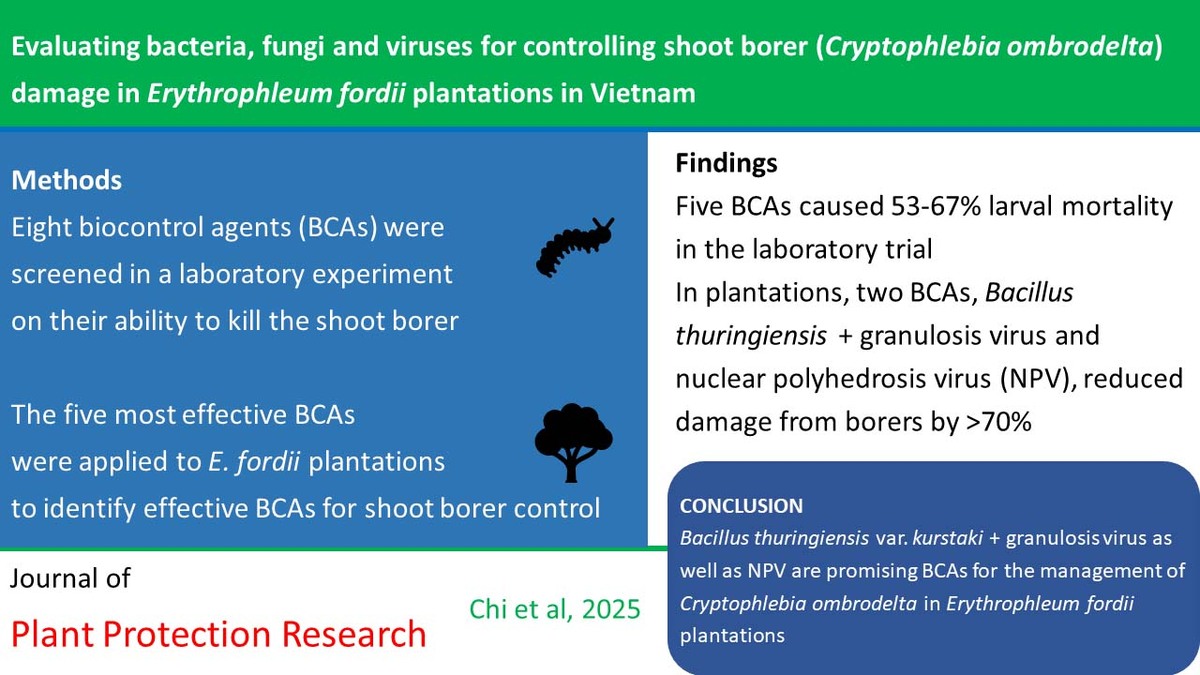ORIGINAL ARTICLE
Evaluating bacteria, fungi and viruses for controlling shoot borer (Cryptophlebia ombrodelta) damage in Erythrophleum fordii plantations in Vietnam
1
Forest Protection Research Centre, Vietnamese Academy of Forest Sciences, Duc Thang, 11910, Hanoi, Viet Nam
2
Science, Post-graduate and International Cooperation Department, Vietnamese Academy of Forest Sciences, Duc Thang, 11910, Hanoi, Viet Nam
3
Agriculture and Forest Sciences, Murdoch University, Murdoch, 6150, Murdoch, Australia
A - Research concept and design; B - Collection and/or assembly of data; C - Data analysis and interpretation; D - Writing the article; E - Critical revision of the article; F - Final approval of article
Submission date: 2025-03-28
Acceptance date: 2025-08-12
Online publication date: 2025-08-20
Corresponding author
Nguyen Minh Chi
Forest Protection Research Centre, Vietnamese Academy of Forest Sciences, Duc Thang, 11910, Hanoi, Viet Nam
Forest Protection Research Centre, Vietnamese Academy of Forest Sciences, Duc Thang, 11910, Hanoi, Viet Nam
HIGHLIGHTS
- Bacteria and virus can be used to control C. ombrodelta
- B. thuringiensis + Granulosis virus or NPV are suitable biocontrol agents
- Applications of biocontrol agents necessary to manage this pest
KEYWORDS
TOPICS
ABSTRACT
Erythrophleum fordii has been prioritized for use in sawtimber production and forest restoration programs with native tree species in Vietnam. However, the shoot borer Cryptophlebia ombrodelta (Lower, 1898) (Lepidoptera: Tortricidae) is becoming a serious pest in E. fordii plantations. This study evaluated the potency of biological agents to control C. ombrodelta in laboratory and field experiments. Eight biological control agents (BCAs) were prescreened in a laboratory trial and the five most effective BCAs were evaluated in a one-year-old plantation. Spraying foliage with Bacillus thuringiensis var. kurstaki + granulosis virus or nuclear polyhedrosis virus at concentrations of 4 g/l and 4 ml/l, respectively, reduced damage from C. ombrodelta by over 70% compared to the water control. The findings can guide further research on the timing and frequency of applications of BCAs necessary to manage the pest in young stands of E. fordii.
CONFLICT OF INTEREST
The authors have declared that no conflict of interests exist.
Share
RELATED ARTICLE
We process personal data collected when visiting the website. The function of obtaining information about users and their behavior is carried out by voluntarily entered information in forms and saving cookies in end devices. Data, including cookies, are used to provide services, improve the user experience and to analyze the traffic in accordance with the Privacy policy. Data are also collected and processed by Google Analytics tool (more).
You can change cookies settings in your browser. Restricted use of cookies in the browser configuration may affect some functionalities of the website.
You can change cookies settings in your browser. Restricted use of cookies in the browser configuration may affect some functionalities of the website.




